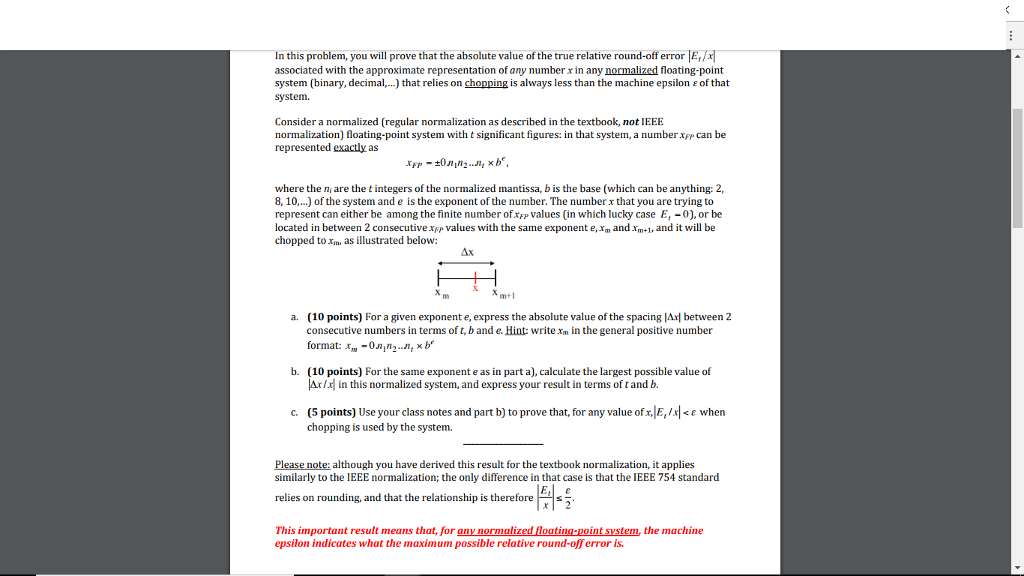
In this problem, you will prove that the absolute value of the true relative round-off error E, associated with the approximate representation of any number x in any normalized floating-point system (binary, decimal, ) that relies on chopping is always less than the machine epsilon of that system. Consider a normalized (regular normalization as described in the textbook, not IEEE normalization) floating-point system with t significant figures: in that system, a number xpp can be represented exactly as where the n are the t integers of the normalized mantissa, b is the base (which can be anything: 2, 8,10) of the system and e is the exponent of the number. The number x that you are trying to represent can either be among the finite number of xp Values (in which lucky case E, -0), or be located in between 2 consecutive x values with the same exponent e, xm and xm1, and it will be chopped to m as illustrated below: Ax m+1 a. (10 points) For a given exponent e, express the absolute value of the spacing Axbetween 2 consecutive numbers in terms of t, b and e. Hint: write m in the general positive number format: x-0, xb Ar/xl in this normalized system, and express your result in terms of t and b. (5 points) Use your class notes and part b) to prove that, for any value of x,IE-r- when b. (10 points) For the same exponent e as in part a), calculate the largest possible value of chopping is used by the system. Please note: although you have derived this result for the textbook normalization, it applies similarly to the IEEE normalization; the only difference in that case is that the IEEE 754 standard relies on rounding, and that the relationship is therefore This important result means that, for any normalized floating-point system, the machine epsilon indicates what the maximum possible relative round-offerror is. In this problem, you will prove that the absolute value of the true relative round-off error E, associated with the approximate representation of any number x in any normalized floating-point system (binary, decimal, ) that relies on chopping is always less than the machine epsilon of that system. Consider a normalized (regular normalization as described in the textbook, not IEEE normalization) floating-point system with t significant figures: in that system, a number xpp can be represented exactly as where the n are the t integers of the normalized mantissa, b is the base (which can be anything: 2, 8,10) of the system and e is the exponent of the number. The number x that you are trying to represent can either be among the finite number of xp Values (in which lucky case E, -0), or be located in between 2 consecutive x values with the same exponent e, xm and xm1, and it will be chopped to m as illustrated below: Ax m+1 a. (10 points) For a given exponent e, express the absolute value of the spacing Axbetween 2 consecutive numbers in terms of t, b and e. Hint: write m in the general positive number format: x-0, xb Ar/xl in this normalized system, and express your result in terms of t and b. (5 points) Use your class notes and part b) to prove that, for any value of x,IE-r- when b. (10 points) For the same exponent e as in part a), calculate the largest possible value of chopping is used by the system. Please note: although you have derived this result for the textbook normalization, it applies similarly to the IEEE normalization; the only difference in that case is that the IEEE 754 standard relies on rounding, and that the relationship is therefore This important result means that, for any normalized floating-point system, the machine epsilon indicates what the maximum possible relative round-offerror is







